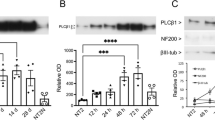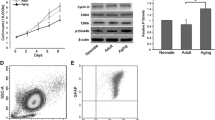Abstract
Cytoplasmic polyadenylation binding protein 1 (CPEB1) is a RNA binding protein, which regulates translation of target mRNAs by regulating polyadenylation status. CPEB1 plays important roles in the regulation of germline cell development by modulating cell cycle progression through the polyadenylation of target mRNAs such as cyclin B1. Similar mechanism is reported in proliferating astrocytes by us, although CPEB1 is involved in the transport of target mRNAs as well as local translation at dendritic spines. In this study, we found the expression of CPEB1 in cultured rat primary neural progenitor cells (NPCs). EGF stimulation of cultured NPCs induced rapid phosphorylation of CPEB1, a hallmark of CPEB1-dependent translational control along with cyclin B1 polyadenylation and translation. EGF-induced activation of ERK1/2 and Aurora A kinase was responsible for CPEB1 phosphorylation. Pharmacological inhibition studies suggested that ERK1/2 is involved in the activation of Aurora A kinase and regulation of CPEB1 phosphorylation in cultured NPCs. Long-term incubation in EGF resulted in the down-regulation of CPEB1 expression, which further increased expression of cyclin B1 and cell cycle progression. When we down-regulated the expression of CPEB1 in NPCs by siRNA transfection, the proliferation of NPCs was increased. Increased NPCs proliferation by down-regulation of CPEB1 resulted in eventual up-regulation of neuronal differentiation with increase in both pre- and post-synaptic proteins. The results from the present study may suggest the importance of translational control in the regulation of neuronal development, an emerging concept in many neurodevelopmental and psychiatric disorders such as autism spectrum disorder.






Similar content being viewed by others
References
Hake LE, Richter JD (1994) CPEB is a specificity factor that mediates cytoplasmic polyadenylation during Xenopus oocyte maturation. Cell 79(4):617–627
de Moor CH, Richter JD (1999) Cytoplasmic polyadenylation elements mediate masking and unmasking of cyclin B1 mRNA. EMBO J 18(8):2294–2303
Mendez R, Hake LE, Andresson T, Littlepage LE, Ruderman JV, Richter JD (2000) Phosphorylation of CPE binding factor by Eg2 regulates translation of c-mos mRNA. Nature 404(6775):302–307. doi:10.1038/35005126
Mendez R, Barnard D, Richter JD (2002) Differential mRNA translation and meiotic progression require Cdc2-mediated CPEB destruction. EMBO J 21(7):1833–1844
Dickson KS, Bilger A, Ballantyne S, Wickens MP (1999) The cleavage and polyadenylation specificity factor in Xenopus laevis oocytes is a cytoplasmic factor involved in regulated polyadenylation. Mol Cell Biol 19(8):5707–5717
Mendez R, Murthy KG, Ryan K, Manley JL, Richter JD (2000) Phosphorylation of CPEB by Eg2 mediates the recruitment of CPSF into an active cytoplasmic polyadenylation complex. Mol Cell 6(5):1253–1259. doi:S1097-2765(00)00121-0
Stebbins-Boaz B, Cao Q, de Moor CH, Mendez R, Richter JD (1999) Maskin is a CPEB-associated factor that transiently interacts with elF-4E. Mol Cell 4(6):1017–1027
Setoyama D, Yamashita M, Sagata N (2007) Mechanism of degradation of CPEB during Xenopus oocyte maturation. Proc Natl Acad Sci USA 104(46):18001–18006
Reverte CG, Ahearn MD, Hake LE (2001) CPEB degradation during Xenopus oocyte maturation requires a PEST domain and the 26S proteasome. Dev Biol 231(2):447–458
Thom G, Minshall N, Git A, Argasinska J, Standart N (2003) Role of cdc2 kinase phosphorylation and conserved N-terminal proteolysis motifs in cytoplasmic polyadenylation-element-binding protein (CPEB) complex dissociation and degradation. Biochem J 370(Pt 1):91–100
Tung JJ, Padmanabhan K, Hansen DV, Richter JD, Jackson PK (2007) Translational unmasking of Emi2 directs cytostatic factor arrest in meiosis II. Cell Cycle 6(6):725–731
Wu L, Wells D, Tay J, Mendis D, Abbott MA, Barnitt A, Quinlan E, Heynen A, Fallon JR, Richter JD (1998) CPEB-mediated cytoplasmic polyadenylation and the regulation of experience-dependent translation of alpha-CaMKII mRNA at synapses. Neuron 21(5):1129–1139
Di Nardo AA, Nedelec S, Trembleau A, Volovitch M, Prochiantz A, Montesinos ML (2007) Dendritic localization and activity-dependent translation of Engrailed1 transcription factor. Mol Cell Neurosci 35(2):230–236
Stebbins-Boaz B, Hake LE, Richter JD (1996) CPEB controls the cytoplasmic polyadenylation of cyclin, Cdk2 and c-mos mRNAs and is necessary for oocyte maturation in Xenopus. EMBO J 15(10):2582–2592
Barnard DC, Cao Q, Richter JD (2005) Differential phosphorylation controls Maskin association with eukaryotic translation initiation factor 4E and localization on the mitotic apparatus. Mol Cell Biol 25(17):7605–7615
O’Brien LL, Albee AJ, Liu L, Tao W, Dobrzyn P, Lizarraga SB, Wiese C (2005) The Xenopus TACC homologue, Maskin, functions in mitotic spindle assembly. Mol Biol Cell 16(6):2836–2847
Peset I, Seiler J, Sardon T, Bejarano LA, Rybina S, Vernos I (2005) Function and regulation of Maskin, a TACC family protein, in microtubule growth during mitosis. J Cell Biol 170(7):1057–1066
Groisman I, Huang YS, Mendez R, Cao Q, Theurkauf W, Richter JD (2000) CPEB, maskin, and cyclin B1 mRNA at the mitotic apparatus: implications for local translational control of cell division. Cell 103(3):435–447
Fu J, Bian M, Jiang Q, Zhang C (2007) Roles of Aurora kinases in mitosis and tumorigenesis. Mol Cancer Res 5(1):1–10
Marumoto T, Zhang D, Saya H (2005) Aurora-A—a guardian of poles. Nat Rev Cancer 5(1):42–50
Atkins CM, Davare MA, Oh MC, Derkach V, Soderling TR (2005) Bidirectional regulation of cytoplasmic polyadenylation element-binding protein phosphorylation by Ca2+/calmodulin-dependent protein kinase II and protein phosphatase 1 during hippocampal long-term potentiation. J Neurosci 25(23):5604–5610
Huang YS, Carson JH, Barbarese E, Richter JD (2003) Facilitation of dendritic mRNA transport by CPEB. Genes Dev 17(5):638–653
Kim KC, Oh WJ, Ko KH, Shin CY, Wells DG (2011) Cyclin B1 expression regulated by cytoplasmic polyadenylation element binding protein in astrocytes. J Neurosci 31(34):12118–12128. doi:10.1523/JNEUROSCI.1621-11.2011
Tay J, Richter JD (2001) Germ cell differentiation and synaptonemal complex formation are disrupted in CPEB knockout mice. Dev Cell 1(2):201–213
Racki WJ, Richter JD (2006) CPEB controls oocyte growth and follicle development in the mouse. Development 133(22):4527–4537 (Cambridge, England)
Minshull J, Blow JJ, Hunt T (1989) Translation of cyclin mRNA is necessary for extracts of activated Xenopus eggs to enter mitosis. Cell 56(6):947–956
Murray AW, Kirschner MW (1989) Cyclin synthesis drives the early embryonic cell cycle. Nature 339(6222):275–280
Go HS, Seo JE, Kim KC, Han SM, Kim P, Kang YS, Han SH, Shin CY, Ko KH (2011) Valproic acid inhibits neural progenitor cell death by activation of NF-κB signaling pathway and up-regulation of Bcl-XL. J Biomed Sci 18(1):48. doi:10.1186/1423-0127-18-48
Rassa JC, Wilson GM, Brewer GA, Parks GD (2000) Spacing constraints on reinitiation of paramyxovirus transcription: the gene end U tract acts as a spacer to separate gene end from gene start sites. Virology 274(2):438–449
Jones KJ, Korb E, Kundel MA, Kochanek AR, Kabraji S, McEvoy M, Shin CY, Wells DG (2008) CPEB1 regulates beta-catenin mRNA translation and cell migration in astrocytes. Glia 56(13):1401–1413. doi:10.1002/glia.20707
Tay J, Hodgman R, Richter JD (2000) The control of cyclin B1 mRNA translation during mouse oocyte maturation. Dev Biol 221(1):1–9. doi:10.1006/dbio.2000.9669
Keady BT, Kuo P, Martinez SE, Yuan L, Hake LE (2007) MAPK interacts with XGef and is required for CPEB activation during meiosis in Xenopus oocytes. J Cell Sci 120(Pt 6):1093–1103. doi:10.1242/jcs.03416
Ota R, Kotani T, Yamashita M (2011) Possible involvement of Nemo-like kinase 1 in Xenopus oocyte maturation as a kinase responsible for Pumilio1, Pumilio2, and CPEB phosphorylation. Biochemistry 50(25):5648–5659. doi:10.1021/bi2002696
Ota S, Ishitani S, Shimizu N, Matsumoto K, Itoh M, Ishitani T (2012) NLK positively regulates Wnt/beta-catenin signalling by phosphorylating LEF1 in neural progenitor cells. EMBO J 31(8):1904–1915. doi:10.1038/emboj.2012.46
Atkins CM, Nozaki N, Shigeri Y, Soderling TR (2004) Cytoplasmic polyadenylation element binding protein-dependent protein synthesis is regulated by calcium/calmodulin-dependent protein kinase II. J Neurosci 24(22):5193–5201. doi:10.1523/JNEUROSCI.0854-04.2004
Alexandrov IM, Ivshina M, Jung DY, Friedline R, Ko HJ, Xu M, O’Sullivan-Murphy B, Bortell R, Huang YT, Urano F, Kim JK, Richter JD (2012) Cytoplasmic polyadenylation element binding protein deficiency stimulates PTEN and Stat3 mRNA translation and induces hepatic insulin resistance. PLoS Genet 8(1):e1002457. doi:10.1371/journal.pgen.1002457
Yang Q, Allard P, Huang M, Zhang W, Clarke HJ (2010) Proteasomal activity is required to initiate and to sustain translational activation of messenger RNA encoding the stem-loop-binding protein during meiotic maturation in mice. Biol Reprod 82(1):123–131. doi:10.1095/biolreprod.109.076588
Banko JL, Poulin F, Hou L, DeMaria CT, Sonenberg N, Klann E (2005) The translation repressor 4E-BP2 is critical for eIF4F complex formation, synaptic plasticity, and memory in the hippocampus. J Neurosci 25(42):9581–9590. doi:10.1523/JNEUROSCI.2423-05.2005
Santini E, Huynh TN, MacAskill AF, Carter AG, Pierre P, Ruggero D, Kaphzan H, Klann E (2013) Exaggerated translation causes synaptic and behavioural aberrations associated with autism. Nature 493(7432):411–415. doi:10.1038/nature11782
Rogers SJ, Wehner DE, Hagerman R (2001) The behavioral phenotype in fragile X: symptoms of autism in very young children with fragile X syndrome, idiopathic autism, and other developmental disorders. J Dev Behav Pediatr 22(6):409–417
Hagerman RJ, Ono MY, Hagerman PJ (2005) Recent advances in fragile X: a model for autism and neurodegeneration. Curr Opin Psychiatry 18(5):490–496. doi:10.1097/01.yco.0000179485.39520.b0
Hatton DD, Sideris J, Skinner M, Mankowski J, Bailey DB Jr, Roberts J, Mirrett P (2006) Autistic behavior in children with fragile X syndrome: prevalence, stability, and the impact of FMRP. Am J Med Genet A 140A(17):1804–1813. doi:10.1002/ajmg.a.31286
Acknowledgments
This work was supported by a grant of the Korean Health Technology R&D Project, Ministry of health & welfare, Republic of Korea (No. A120029), and the framework of international cooperation program (2012K2A1A2032549) through the National Research Foundation of Korea (NRF) grant funded by the Korea government (MEST).
Conflict of interest
None.
Author information
Authors and Affiliations
Corresponding authors
Additional information
Ki Chan Kim and Ji-Woon Kim have contributed equally to this work.
Rights and permissions
About this article
Cite this article
Kim, K.C., Kim, JW., Choi, C.S. et al. A Role of CPEB1 in the Modulation of Proliferation and Neuronal Maturation of Rat Primary Neural Progenitor Cells. Neurochem Res 38, 1960–1972 (2013). https://doi.org/10.1007/s11064-013-1102-4
Received:
Revised:
Accepted:
Published:
Issue Date:
DOI: https://doi.org/10.1007/s11064-013-1102-4




